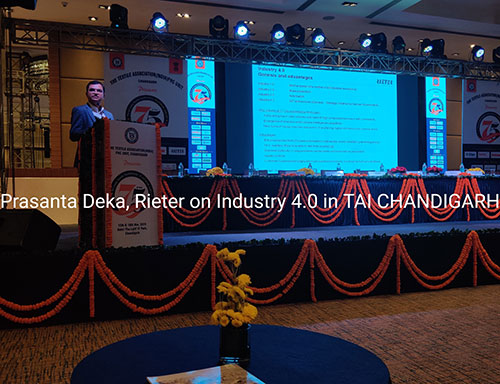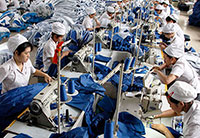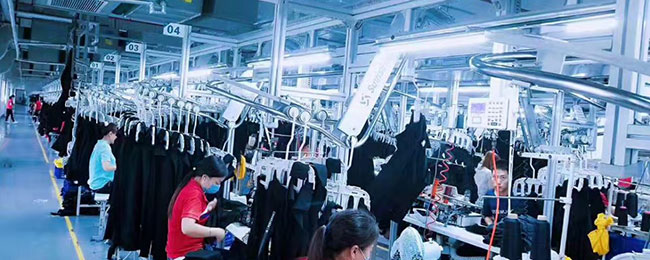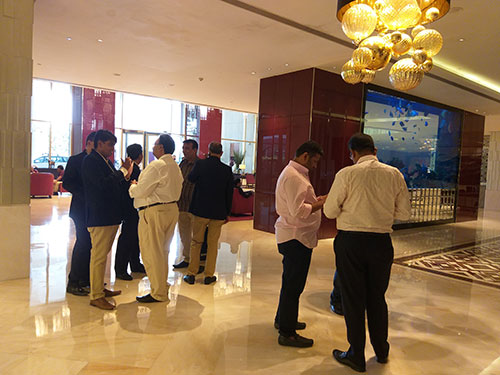FW
As per the Bain-Altagamma 2019 Worldwide Luxury Market Monitor, the global luxury market grew by 4 per cent in 2019 with Asia contributing most to the growth of this market. The study reveals that the size of the global personal luxury goods market was pegged at € 281 billion in 2019. Of this, Mainland China’s luxury market grew the most bgy 26 per cent at constant exchange rates this year to reach €30 billion. Fuelled by favorable government policies and lower price differentials, Chinese customers accounted for 90 per cent of the constant growth of the market in 2019.
Luxury consumption in Hong Kong was adversely hit by the ongoing protests. The luxury market in the country declined 20 percent to €6 billion. The Hong Kong luxury landscape will reach a new equilibrium, with rules of the game deeply transformed and local customers becoming the main focus according to the report.
Meanwhile, Chinese buyers of luxury turned their sights to other Asian destinations, boosting the performance of these markets. Japan grew by 4 per cent at constant exchange rates to €24 billion while the rest of Asia grew by 6 per cent at constant exchange rates, reaching €42 billion.
Europe experienced a slow growth of 1 per cent at constant exchange rates with the market reaching €88 billion in size. Driven by tourism and weak currency, Spain and the UK were among the top performers. Germany was impacted by a slowing country dynamism and France by social unrest earlier in the year. Other geographies, which account for €12 billion, experienced a 5% decrease at constant exchange rates. The Middle East, aside from a hesitant recovery in Dubai, was a subdued market affected by lower consumer confidence and geopolitical uncertainties.
Latest Moody report says, tariffs on Chinese imports will negatively impact clothing and footwear retail in the American market between the next twelve and eighteen months. The report predicts sales to decline by 5 per cent between the next twelve and eighteen months.
Sales will be affected by risks such as commercial friction and Brexit as pressure within the sector will increase. Last September, United States imposed a 15 per cent tariff on most of China’s clothing imports and plans to apply another tax on December 15. The strengthening of the dollar will also affect the sector, since it will result in increase in costs.
The figures by National Retail Federation reveal that sales of clothing and clothing accessory declined by 2.6 per cent year-over-year in the US. However, these sales increased by 1 per cent in March seasonally adjusted from February and up 0.8 per cent unadjusted year-over-year.
 FashionatingWorld had an interaction with Prashant Deka head marketing rieter on the sidelines of TAI 75th year Summit at Chandigarh dated 15-11-19. He is of the opinion that 'Industry 4.0' is nomore optional rather it is now a business imperative. Going by his experience he still thinks that the uptick in this technology is limited in the near future: not that technology is not required in Indian textile and apparel space, not that we have best of the productivity, not that we are proficiently competitive. The reasons are not far from evident textile space continues to languish and will as long as it is not able to deal with the present day limitations viz. Not so good physical infrastructure, High cost of finance, Ever increasingly rising cost of living, typical Indian entrepreneur mind set of being capital shy & resistance to change.
FashionatingWorld had an interaction with Prashant Deka head marketing rieter on the sidelines of TAI 75th year Summit at Chandigarh dated 15-11-19. He is of the opinion that 'Industry 4.0' is nomore optional rather it is now a business imperative. Going by his experience he still thinks that the uptick in this technology is limited in the near future: not that technology is not required in Indian textile and apparel space, not that we have best of the productivity, not that we are proficiently competitive. The reasons are not far from evident textile space continues to languish and will as long as it is not able to deal with the present day limitations viz. Not so good physical infrastructure, High cost of finance, Ever increasingly rising cost of living, typical Indian entrepreneur mind set of being capital shy & resistance to change.
AlsoTextile Sector nomore remains incredibly priority sector despite of being acknowledged as in ultimate job creator only next to agriculture.
Deki avers though the uptake in embracing cutting edge technology maybe slower than what we would argue, but the adoption is inevitable especially given the government diktat of making country 5T $ economy and Textile 350mn $ in specific in coming 4-5 years.Arguably as a piece it again is not really important what is the aggregate composition of the textile growth pie in the terms of the domestic and exports break down so far there is objective progression (economists and purist alike in the private space see it doable as long as administrators/ law makers can well deal with the current limitations which the semblance is they are quite seized of).
His prescription is that there is bunch of solutions & in his admission at times it can be interim but most of the times it will be the remedial steps to fix the trade/ economy which I don't think I need to allude here as they all are evidently known to our policy makers.
"China still holds a 31.5 percent share in the US textiles and apparel market. However, its share in world exports declined nearly 2 per cent in 2019 from the previous year. Latest Chinese Customs statistics from January to August 2019 reveal among the top 10 garment exporters in China, American brands such as Nike and Gap have maintained sustainable growth"
 Even amidst the ongoing tariff war between the United States and China, Chinese textiles and apparel sector seems to be faring quite well. Recent data reveals, China’s total export of textiles and clothes in 2019 recorded a 7.9 per cent year-on-year increase to reach $48.96 billion. However, the country’s exports slowed down 1.6 per cent during the first half of the year. Of this, clothing accounted for 73 per cent while textiles made up the remaining 27 per cent of total exports.
Even amidst the ongoing tariff war between the United States and China, Chinese textiles and apparel sector seems to be faring quite well. Recent data reveals, China’s total export of textiles and clothes in 2019 recorded a 7.9 per cent year-on-year increase to reach $48.96 billion. However, the country’s exports slowed down 1.6 per cent during the first half of the year. Of this, clothing accounted for 73 per cent while textiles made up the remaining 27 per cent of total exports.
China still holds a 31.5 percent share in the US textiles and apparel market. However, its share in world exports declined nearly 2 per cent in 2019 from the previous year. Latest Chinese Customs statistics from January to August 2019 reveal among the top 10 garment exporters in China, American brands such as Nike and Gap have maintained sustainable growth.
Brands, retailers cut back China operations

Many US brands and retailers are planning to scale-down their operations in order to avoid the risk fuelled by future uncertainty. A recent survey conducted during the Sourcing Summit New York revealed that around 35 percent attendees from major global apparel brands and retailers planned to reduce their sourcing from China by around 50 percent. They plan to diversify their sourcing to other alternatives like Vietnam, Bangladesh and Cambodia though many of them still rely on inputs from China.
Countries like Vietnam, Cambodia and Bangladesh offer these companies an opportunity to serve US brands and retailers and also avoid tariffs. In the next five years, these companies plan to transfer 20 to 30 per cent of their production to overseas factories.
Unparalleled efficiency enables China retain position
However, China still remains the centre of manufacturing for apparel and textile companies as the country offers unparalleled efficiency beyond the reach of other Asian nations. Easy availability of raw materials in China also enhances its supply chain efficiency and speed to market.
The delivery time for products with complex procedures is almost a month slower in Southeast Asia than in China. Therefore, brands selling fast-fashion are more in numbers in China than in any other country. The status of progress on talks toward an agreement on trade between the US and China still remains unclear however, China hopes to reach an agreement soon.
LVMH plans to take over Tiffany & Co for $16.9bn including net debt, equivalent to nearly four years’ sales at the company. The acquisition consolidates LVMH’s position in the luxury market. In the past five years, the company’s shares have risen threefold which includes a 60 per cent run since January. The brand is currently worth around €206bn (£175bn) and now vies with Royal Dutch Shell as the most valuable firm based in the EU.
This will be 76th brand in the Parisian group’s portfolio, joining Louis Vuitton, Dior and Veuve Clicquot champagne. LVMH emerged as the most obvious buyer for Tiffany in part because its scale begets advantages not available to smaller bauble-peddlers. The brand’s shareholders had pestered management to improve margins and raise sales fast, unduly hurrying its turnaround efforts.
LVMH will give Tiffany time and money to renovate stores and push upmarket.
Intense price competition among readymade garment makers in Asia has resulted in reduced profit margins for Bangladesh clothing exporters. The country has to import most of the raw materials for the sector. Apparel exports of the country have declined in recent months due to worldwide sluggish demand while its competitors have seen a rise. Bangladesh has a higher lead time and it imports cotton from abroad which increases the cost and impedes its exports.
On the other hand, since Pakistan and Vietnam source most raw materials locally, their products are marked with lower prices. In the first four months of the current fiscal year apparel exports of Bangladesh decreased 6.67 per cent. On the other hand, Vietnam’s earnings from apparel exports increased by 10.54 per cent. Also the inflow of investment into Bangladesh’s garment sector is sluggish both in terms of new entrepreneurship and expansion as buyers are not paying good prices. Europe is the pivotal export market for Bangladesh but has reduced imports. In general the online apparel market is affecting export growth.
In the last seven months 59 garment factories have shut down and 25,900 workers have lost their jobs. In July-October of this fiscal year, Bangladesh’s earnings from knitwear exports were up 5.73 per cent.
According to latest Chinese Customs Statistics from January to August 2019, China’s exports of textiles and apparels to the US, during the first half of 2019, reached $21.23 billion, with growth slowing by 1.6 per cent year over year. Clothing accounts for 73 per cent of those exports, and textiles make up the other 27 per cent.
Growth of China’s textile exports is higher than in the garment sector. This is mainly due to the incompleteness of supply chains of low-cost countries like Bangladesh and Cambodia. Shortage of raw materials and fabrics boosted China’s textile exports as well. A survey conducted at last month’s Sourcing Summit New York revealed 35 per cent attendees from major global apparel brands and retailers intend to reduce their China sourcing.
Those investments are going toward setups in places like Vietnam, Cambodia and Bangladesh, in order to retain an opportunity to serve US brands and retailers wherever they’re headed, and to avoid the tariffs that are making things tricky in China, however, many still rely on inputs from China.
For some products with complex procedures, the delivery time in Southeast Asia is at least one month slower than in China. Therefore, brands with fast-fashion items that need to be replenished quickly are still better off staying in China.
Denimsandjeans will be held in Japan, March 4 to 5, 2020, Vietnam, May 28 to 29, 2020, and India, July 8 to 9, 2020.
Organisers are expecting the shows to be bigger and better. Vietnam has been becoming one of the most favorable and important sourcing destinations, especially for US and EU buyers. Vietnam has signed a free trade agreement with Europe, which will create much interest from buyers in the EU. A large number of garment exporters are expected to join the Denimsandjeans shows in 2020 as the event has gained more traction. The industry has embraced these shows as they are focused and niche. The prime attraction of these shows has been the visits of decision-makers from domestic as well as international brands and the presence of almost all who matter in the industry. The knowledge sessions by international experts on important issues also create great interest among professionals who seek to upgrade their knowledge.
Vietnam has currently about 6,000 garment related companies that employ 2.5 million people. As far as India is concerned, denim has been one of the apparel segments that have seen maximum growth in the last decade. In the last 10 years, the growth has been over 10 per cent a year, making the country the second largest consumer of denim after China. Though there has been a correction of late, innovative products still command a premium in the Indian market.
 FSA, the only association representing wholesale fabric suppliers in the entire garment industry, organises two ‘Textrade’ fabric fairs every year in Mumbai. The two-day event presents a golden opportunity to its visitors to showcase fabric creativity, design innovation, splash of colors and fashion extravaganza for the seasons. The association recently held the 25th edition of the fair. Nilesh Shah, Ex-Secretary and Founder Member, Fabric Suppliers Association of India, elaborates on this fair and the association.
FSA, the only association representing wholesale fabric suppliers in the entire garment industry, organises two ‘Textrade’ fabric fairs every year in Mumbai. The two-day event presents a golden opportunity to its visitors to showcase fabric creativity, design innovation, splash of colors and fashion extravaganza for the seasons. The association recently held the 25th edition of the fair. Nilesh Shah, Ex-Secretary and Founder Member, Fabric Suppliers Association of India, elaborates on this fair and the association.
What were the reasons behind the inception of this fair?
As we shared a very good relationship with our traders, both of us were aware of the problems faced by each. However, we did not have a platform to address these problems. One of our old members suggested that we create such a platform that facilitates our interaction with each other. Thus, the idea of Fabric Suppliers Association was born. The association has been involved with all types of traders since the last 12 years and offers them a platform to share their grievance, experiences, etc.
How will this trade fair benefit the industry?
This is the only trading community fair which is a one stop shop for all garment manufacturers across India. The fair showcases a wide range of garments including ladies wear, men’s wear, kids wear to winter. Held twice in a year, the fair is organised in a proper systematic manner. It showcases all upcoming garment trends six months in advance.
What are your reasons for restricting this fair to Mumbai only?
We wanted to gauge the fair’s performance for atleast 10 years before expanding it to other cities like Delhi, Kolkata, Chennai, Bengaluru and overseas. We also plan to expand this fair to other countries like Bangladesh, Sri Lanka and Dubai which not only enable our traders to display their collections across the world but also allow our customers to avail of latest fashion at affordable rates. Another of our plan includes foraying into South East Asia market which is a major manufacturing hub.
Do you think other Indian cities will give you the same kind of foothold that Mumbai provides?
All Indian cities have their distinctive features. Even Bengaluru, Kolkatta and Delhi are as promising and happening like Mumbai. They also house some good garment manufacturers besides a huge market. We plan to cover all these cities on the basis of the response we get in these markets and how many new members we add to our association.
There are a lot of garment manufacturers mushrooming in Mumbai. How many of these were you able to tap?
We were able to reach out to almost 90 per cent of our customers and convey the fair dates two months in advance. This was done through our huge mailing list and a large network of people. We conveyed this message on pan India basis which enabled these visitors to book their flight tickets at cheaper rates. By 2020, we aim to reach out to 100 per cent of our customers across India.
How helpful has the government been in this? Did you seek its support?
We have been conveying our problems to the government which has been quite serious about addressing our concerns. It is trying to address several of our issues including garments imports from Bangladesh, difficult working conditions, employment issues etc. Slowly and gradually, the government is realising the importance of this sector as the second largest employer in the country.
Do you think India’s FTA with Bangladesh restricts its growth in garmenting?
This was a concern previously but now the textile ministry is taking a serious note of garment imports from Bangladesh. It addresses all the challenges and sorts out abnormalities and loop holes. In the next few months, the domestic industry will be on par with the Bangladesh industry.
The garment industry’s diversified portfolio will make it the next big thing and a one stop shop. We can be a supplier to not only our nation but the entire world.
Vietnam is coming up in a very big way. Would you consider it as a challenge for India?
At present it is a challenge. However, India has a large textile manufacturing base which Vietnam does not. In a few years time, all the inadequacies will be sorted out and we will flourish just like Vietnam. Also, Vietnam does not produce all the fabrics like Bangladesh and they are ultimately shipped from India. Therefore all big companies want to set up their manufacturing and as well as sourcing bases in India.
What is the status of FSA trade fairs? How many exhibitors are there and what is the foot fall expected from this particular event?
At present, around 100 exhibitors are participating in this event while over 1,500 people have registered with our company. In all, we expect a footfall of 5,000 people from this event which is quiet a good number considering that this is predominantly a garment manufacturers’ fair and not retailers’.
How do you deal with defaulters?
We have a processing arbitration committee that scrutinises each and every complaint of our members. We try to resolve these grievances amicably. The committee helps in making the trade healthier and flourishing for the new generation. It has received a tremendous response from our members.
Anything else you would like to highlight about FSA?
Both the FSA committee and FSA Arbitrary committee are doing a fantastic job and we are quite optimistic about their future growth prospects.
Following the immensely successful Red Runner which took its cues from the world of running and the Aurelien inspired by the basketball courts, French fashion designer Christian Louboutin recently launched a new sneaker collection – Happyrui.
This season, the designer pays tribute to the iconic tennis shoe that made fashion history both on and off the courts in the 70s. Boasting a new specially developed rubber platform outsole and a singular upper, the Happyrui low-top sneaker is as stylish as it is easy to wear.
From its new metallic CL signature that echoes 70s varsity letters to its contrasting toe cap and singular eyelet system, every detail on this low-top sneaker nods to vintage retro style. True to Maison’s design, codes, the HAPPYRUI mixes materials and textures including suede, lamé leather and a shimmering sequin body, whilst some versions also come with signature spike-adorned a toe cap.












